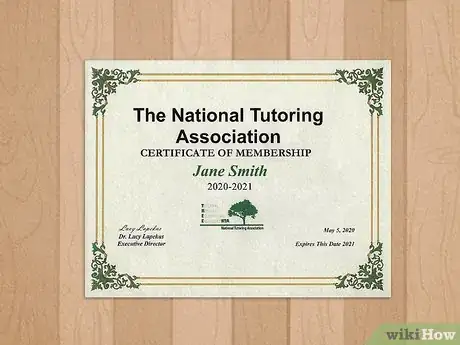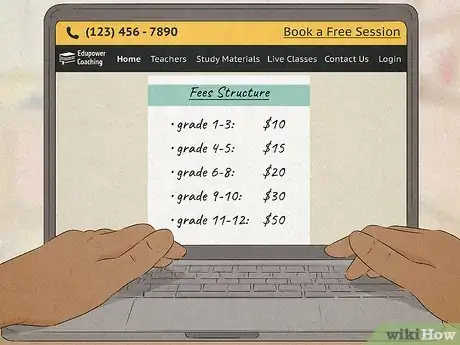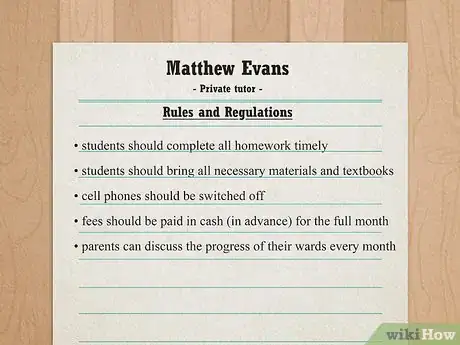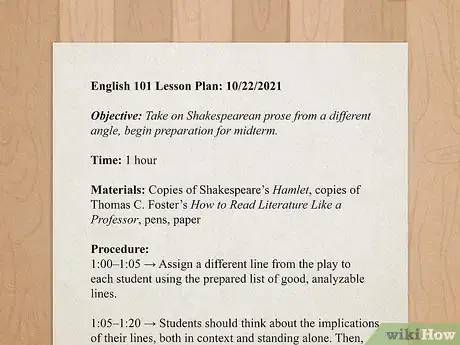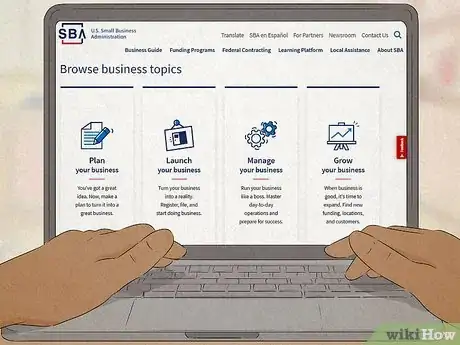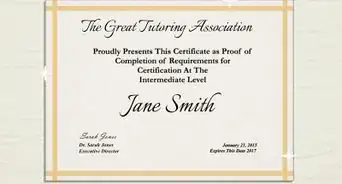This article was co-authored by Sean Alexander, MS. Sean Alexander is an Academic Tutor specializing in teaching mathematics and physics. Sean is the Owner of Alexander Tutoring, an academic tutoring business that provides personalized studying sessions focused on mathematics and physics. With over 15 years of experience, Sean has worked as a physics and math instructor and tutor for Stanford University, San Francisco State University, and Stanbridge Academy. He holds a BS in Physics from the University of California, Santa Barbara and an MS in Theoretical Physics from San Francisco State University.
wikiHow marks an article as reader-approved once it receives enough positive feedback. This article received 15 testimonials and 93% of readers who voted found it helpful, earning it our reader-approved status.
This article has been viewed 280,251 times.
Setting up a home tutoring business is a great way to earn some supplemental income or even make a career change if you’re successful enough. By finding your strengths as a potential tutor, determining the right fees, and marketing your new service, you can go into business for yourself as a tutor.
Things You Should Know
- Get tutoring certifications from The National Tutoring Association (NTA) or American Tutoring Association (ATA) to help you stand out.
- Call reputable tutoring services in your area to learn their rates so you can price competitively. Then, create a consistent fee scale.
- Set up a website and social media profiles to build an online presence. Market your services to schools, libraries, and student organizations.
Steps
Planning Your Tutoring Business
-
1Play to your strengths. Tutors can provide assistance in nearly every subject that students take from elementary school all the way through college. Break down the grade levels and subjects with which you are comfortable enough to tutor students.[1]
- Don’t forget to include those at a lower level. For example, if you’re comfortable tutoring in math all the way through calculus, then you shouldn’t forget to include algebra and geometry students.
- If you’re not a retired teacher, substitute, or otherwise familiar with curriculums in your area, then check with your state’s department of education to see what you must be proficient in to tutor certain grade levels.
- Common Core standards have also been adopted by a number of U.S. states, so you can look into your state’s adoption of these standards for curriculum information as well.
-
2Check out the competition. Call other reputable tutoring services in your area to learn their services and rates. Find out if those rates are based on tutors who are certified or not as well. This research will help when you eventually decide on pricing, and it will also give you the chance to see the areas in which your competition specializes. Use this information to help set your service apart.[2]Advertisement
-
3Consider getting certified.[3] Most states do not require any specialized training for someone to work as a tutor. However, parents are essentially entrusting the academic development of their children to you (not to mention paying for the service), so tutoring certifications can help separate you from the crowded tutor pack—not to mention translate into higher hourly fees. The National Tutoring Association (NTA) and American Tutoring Association (ATA) are two separate organizations that offer certifications to help distinguish your tutoring business.[4]
- You can expect to spend between $200 and $500 for the certification depending on the subjects and course levels at which you seek certification.
-
4Pick a name. Once you know your areas of specialization, you can start building a brand for your business. Choose a name that sets your service apart, and Google it to ensure that it’s not already taken.[5]
- You’ll additionally need to choose a name for the business before you can file for the business license in your state.
-
5Remember that it’s not just tutoring. While you’ll spend the bulk of your time as a tutor assisting students, you must remember that you are still starting a small business. You’ll have to file for the appropriate small business license in your state, perform bookkeeping duties, pay taxes, market your services, etc.[6]
- For more information on these aspects, of the process, check out the information available at How to Start a Small Business.
- If you’re unfamiliar with setting up a business, then you may want to see a tax specialist concerning the best way for you to file.[7] However, you will most likely want to file your business as an LLC or limited liability corporation. This will protect you as the owner from the debts of the business if it fails or any judgments against it.[8]
- You may also want to spend some time talking to a small business attorney who can point you in the right direction regarding state and local ordinances pertaining to liability, such as how to protect yourself in the event of a student injuring himself or herself while in your home.[9]
-
6Set up a space in which your clients can focus. No parents will leave you alone with their children in your own home without first taking a tour of your setup. You’ll need to create a comfortable space with good lighting that is free of noise and other distractions that can interrupt student focus.[10] Your space will obviously need to be clean and properly stocked with the necessary supplies and reference materials for your chosen subject as well.
- Remember to track the expenses of all business-related purchases. You should even calculate the percentage of your monthly rent or mortgage payment that corresponds to the size of your tutoring space. All of these expenses amount to tax deductions that you can apply to your business when filing for the year.
- You should always keep the rest of your home extremely clean as well. The parents will notice as they drop off and pick up their children if other areas of your home appear untidy and unprofessional.
-
7Decide how much time you want to spend tutoring. Do you want to tutor as an additional source of income, or do you want to tutor full-time? Before you can determine your fees, you have to decide whether or not tutoring will become your sole source of income.[11]
- Keep in mind that you’ll have to market specific services if you plan to tutor while most students are actually in school. This includes tutoring students on extended leaves of absence due to injury or illness.
- Tutoring at the college level helps with the daily scheduling since those students have varied schedules.
- It’s normal to tutor in addition to your full-time job (or even another part-time job) as you build up a client base that allows you to transition to tutoring alone with more confidence as well.
-
8Create a consistent fee scale. Deciding what to charge for your services can be one of the hardest parts of setting up a tutoring business. If you plan to work as a full-time tutor, then you must take both the business expenses as well as your general living expenses into account when setting up your fees. Plan to set aside three to six months of living expenses before you quit your current day job in hopes of developing your tutoring business.[12]
- Remember that the higher the grade level and more advanced the subject, the higher you can charge for the service. Tutors may only charge $10 an hour to teach long division, whereas someone tutoring calculus derivatives can charge much more.
Launching Your Tutoring Business
-
1Market yourself. Now that you’ve taken care of the legal and logistical aspects, you’re ready to start finding clients. Create a plan for how you want to market yourself. Get in touch with schools, libraries, and student organizations where you can leave flyers or business cards.[13]
- Keep in mind that while your business applies to the students, you’re ultimately marketing yourself to the parents who will pay your fees.[14]
-
2Build an online presence. Word of mouth is a great way to begin accumulating clients, but a website will also go a long way to build your brand and your business. Many parents—even those who hear positive word-of-mouth recommendations—may not take your business seriously if they can’t find more information on the internet.[15]
- Consider having a blog on your website as well. You can regularly update it with general study tips or other helpful information that helps show you’re active with your website.[16]
- A Facebook page for your tutoring service is another great way to help spread the word.
-
3Decide how to run your sessions. Each student will have varying needs and areas for improvement, but you should set a consistent set of ground rules to provide students and their parents.[17] This can include anything from coming prepared with certain materials to not allowing students to bring beverages into your house that can stain carpets. Organize your rules and create printouts that clearly communicate them.
- Consider offering virtual tutoring appointments in addition to in-person tutoring.[18]
-
4Establish student goals. When you first meet with each student and his or her parent(s), come up with a tutoring plan.[19] Layout a clear idea of the material you’ll need to cover, the number of sessions you anticipate the material taking, how you’ll measure improvement, etc. The clearer and more organized your plan for assisting the student, the more impressed and trusting the child’s parent(s) will be with regard to your abilities.
-
5Stay involved. Don’t take any of those business relationships for granted once you develop them. Provide regular updates to parents regarding what you covered with their children and how far the students are coming along with their respective subjects.[20] The parents will appreciate the progress reports and proof that your service has been a worthwhile investment.
- You may choose to provide feedback on other potential areas of improvement for the children if you see them, but do so tactfully since parents might not react well to hearing that their children need help in other areas.
-
6Remember the other resources available to you. You’re likely to have questions about the business aspects of your tutoring service as you go. Remember to take advantage of resources such as the Small Business Administration (SBA) and local organizations meant to help small businesses in your area.[21] These small business experts want you and your business to succeed, so don’t be afraid to reach out for help.
Expert Q&A
Did you know you can get expert answers for this article?
Unlock expert answers by supporting wikiHow
-
QuestionHow does tutoring online differ from in-person tutoring?
 Sean Alexander, MSSean Alexander is an Academic Tutor specializing in teaching mathematics and physics. Sean is the Owner of Alexander Tutoring, an academic tutoring business that provides personalized studying sessions focused on mathematics and physics. With over 15 years of experience, Sean has worked as a physics and math instructor and tutor for Stanford University, San Francisco State University, and Stanbridge Academy. He holds a BS in Physics from the University of California, Santa Barbara and an MS in Theoretical Physics from San Francisco State University.
Sean Alexander, MSSean Alexander is an Academic Tutor specializing in teaching mathematics and physics. Sean is the Owner of Alexander Tutoring, an academic tutoring business that provides personalized studying sessions focused on mathematics and physics. With over 15 years of experience, Sean has worked as a physics and math instructor and tutor for Stanford University, San Francisco State University, and Stanbridge Academy. He holds a BS in Physics from the University of California, Santa Barbara and an MS in Theoretical Physics from San Francisco State University.
Academic Tutor
-
QuestionHow do I price my home tutoring business?
 Community AnswerI think the best option for you would be to look up the prices for other tutors in your area. This will give you an idea of what people around you are willing to pay for your services.
Community AnswerI think the best option for you would be to look up the prices for other tutors in your area. This will give you an idea of what people around you are willing to pay for your services. -
QuestionHow do I get students for a home tutoring business?
 Community AnswerContact schools and let them help spread the word. You can also advertise your services on sites such as Wyzant, which pairs tutors and students.
Community AnswerContact schools and let them help spread the word. You can also advertise your services on sites such as Wyzant, which pairs tutors and students.
Warnings
- If you plan to offer something like snacks during tutoring sessions, make sure you have the list of available snacks approved by parents. You never know what a child may be allergic to or simply not allowed to have.⧼thumbs_response⧽
- Ensure that you look into the proper business insurance for liability since it can mean costly legal fees if a student inures himself or herself in your home.⧼thumbs_response⧽
References
- ↑ https://www.nerdwallet.com/article/small-business/how-to-start-a-tutoring-business
- ↑ https://www.nerdwallet.com/article/small-business/how-to-start-a-tutoring-business
- ↑ Sean Alexander, MS. Academic Tutor. Expert Interview. 14 May 2020.
- ↑ https://www.nerdwallet.com/article/small-business/how-to-start-a-tutoring-business
- ↑ https://www.nerdwallet.com/article/small-business/how-to-start-a-tutoring-business
- ↑ https://mkai.org/how-to-set-up-a-home-tutoring-business/
- ↑ https://www.care.com/a/how-to-start-a-tutoring-business-1404031555
- ↑ http://www.entrepreneur.com/article/72134
- ↑ https://www.care.com/a/how-to-start-a-tutoring-business-1404031555
- ↑ https://mkai.org/how-to-set-up-a-home-tutoring-business/
- ↑ https://www.care.com/a/how-to-start-a-tutoring-business-1404031555
- ↑ https://mkai.org/how-to-set-up-a-home-tutoring-business/
- ↑ https://mkai.org/how-to-set-up-a-home-tutoring-business/
- ↑ https://www.care.com/a/how-to-start-a-tutoring-business-1404031555
- ↑ https://mkai.org/how-to-set-up-a-home-tutoring-business/
- ↑ https://www.care.com/a/how-to-start-a-tutoring-business-1404031555
- ↑ https://www.nerdwallet.com/article/small-business/how-to-start-a-tutoring-business
- ↑ Sean Alexander, MS. Academic Tutor. Expert Interview. 14 May 2020.
- ↑ Sean Alexander, MS. Academic Tutor. Expert Interview. 14 May 2020.
- ↑ https://www.care.com/a/how-to-start-a-tutoring-business-1404031555
- ↑ https://www.sba.gov/
About This Article
To set up a home tutoring business, start by contacting competitors for their rates so you can develop your own fee scale. As you plan your fees, take into account time you’ll have to spend maintaining your business in addition to time spent assisting students. Then, set up a safe, distraction-free place to work with students, complete with any materials and supplies you need. When your space is ready, begin marketing your business by leaving flyers at libraries and schools or by advertising online. For tips on how to structure your tutoring sessions, read on!


